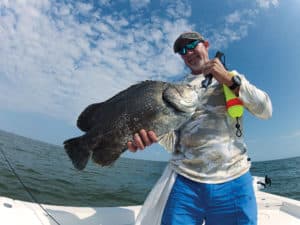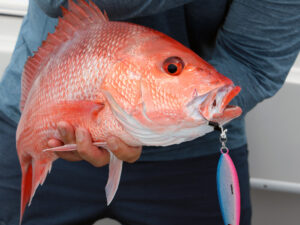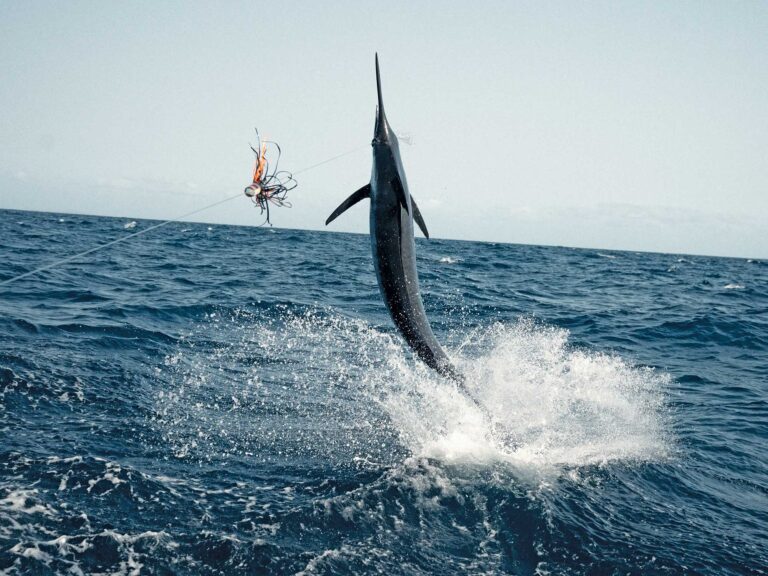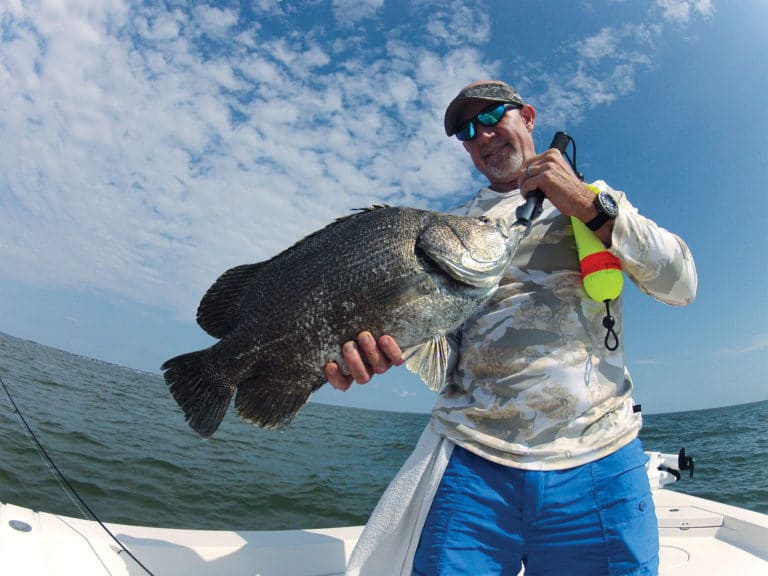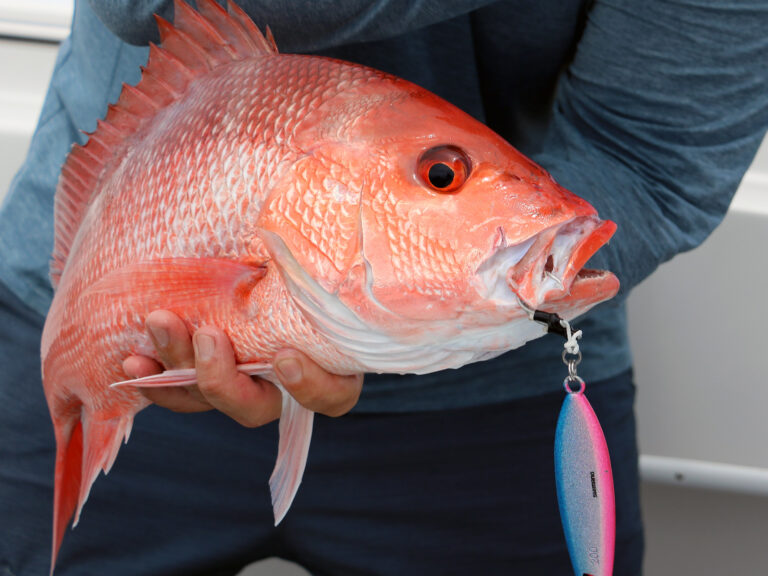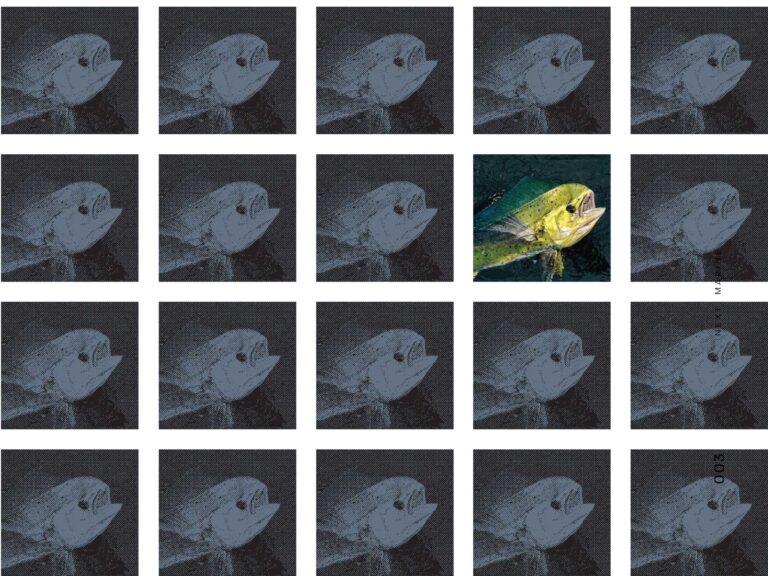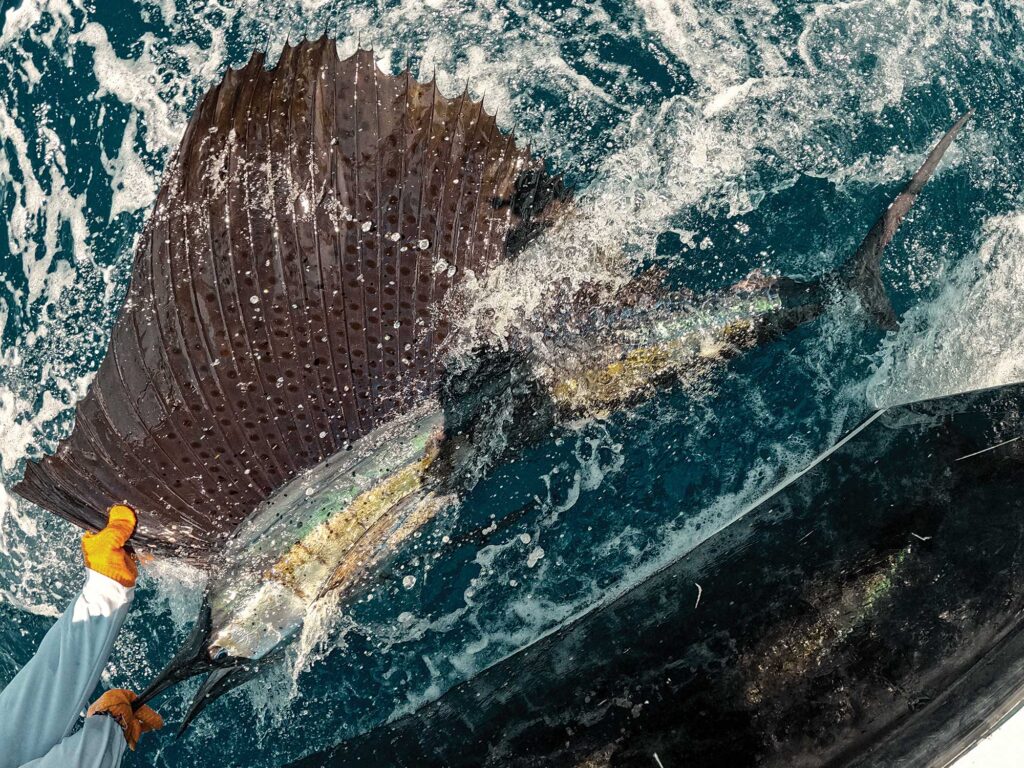
Driving past the man-made hills of granular coal, I recognized Puerto Quetzal was much more than a fishing port. The towering infrastructure, including cranes and conveyors, was hard to miss. That black gold was destined for the San Jose power plant farther north in Masagua, but I was headed for the nearby docks where battled-tested sportboats waited for us. The sailfish bite was too good to miss, and most captains wanted their bow headed for the horizon by 7.
Guatemala offshore fishing in late April has few equals. Columbia Performance Fishing Gear invited us on this Pacific adventure to field-test brand-new long sleeves, pants, shorts and boat shoes in some of the best fishing conditions imaginable. Were we dealing with blood from tuna and dorado? Yep, along with fish poop, fish slime, bait, sweat, sunblock and plenty of other gunk. And how would the Columbia gear protect us from the merciless sun? I wanted to find out. And maybe catch a billfish or three.
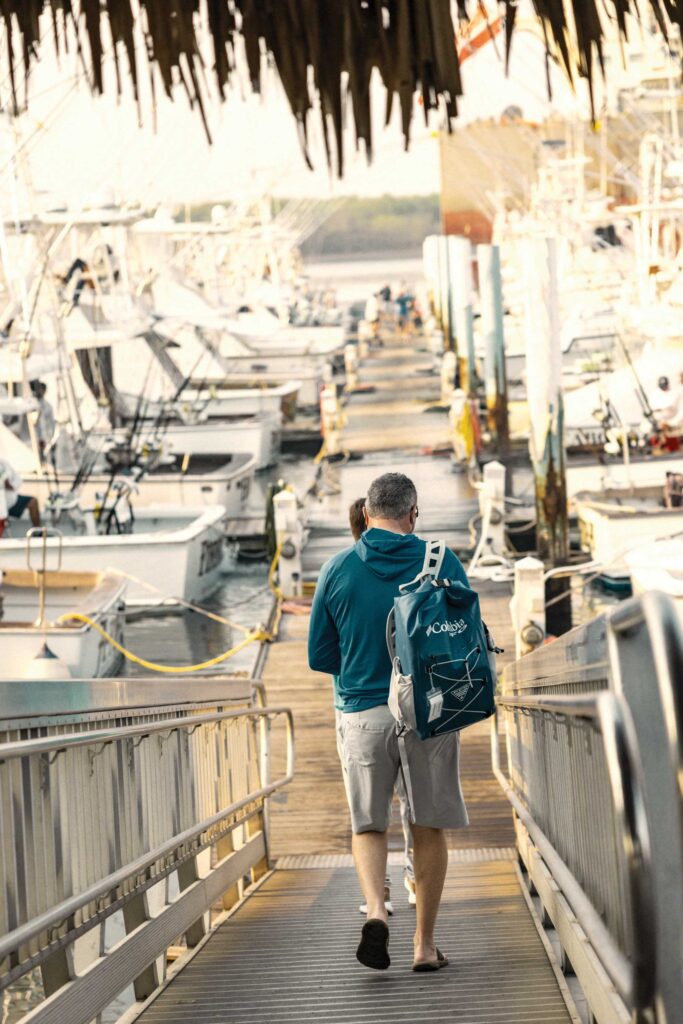
The Best Kind of Trolling
The humming of the engines or the smell of diesel doesn’t separate Guatemala from other places, but the 20-plus cargo ships, container ships and tankers anchored outside the port sure were a sight. Nearby, a cruise ship looked downright amateur in comparison. On the glassy ride out, I tried to spot a volcano—37 in total are in Guatemala, three currently active—but a persistent haze kept me from seeing too far.
The 20 miles to the sailfish grounds went by quickly. Aboard the boat Chechos, a 40-foot Luhrs flybridge, I fished with Columbia’s Andy Nordhoff and Boston-area angler Dave Morel. The boat soon slowed to trolling speeds, the signal for our mates to get the spread deployed. Port and starboard quickly mirrored each other with short and long teasers, and a pair of naked ballyhoo. Lightweight setups—Accurate Valiant 600s with mono—made for fun fishing.
There was no time to sit around and wait. The worst kind of trolling involves long periods of downtime. As soon as lines were in, Capt. Carlos called down to the mates. I thought he wanted them to tweak the spread. Nope, it was a sailfish juiced on one of our teasers. Ricardo quickly picked up the short ballyhoo, fed the sailfish, and passed the rod to me. That’s how fast it happened. I didn’t even have time to sip a drink.
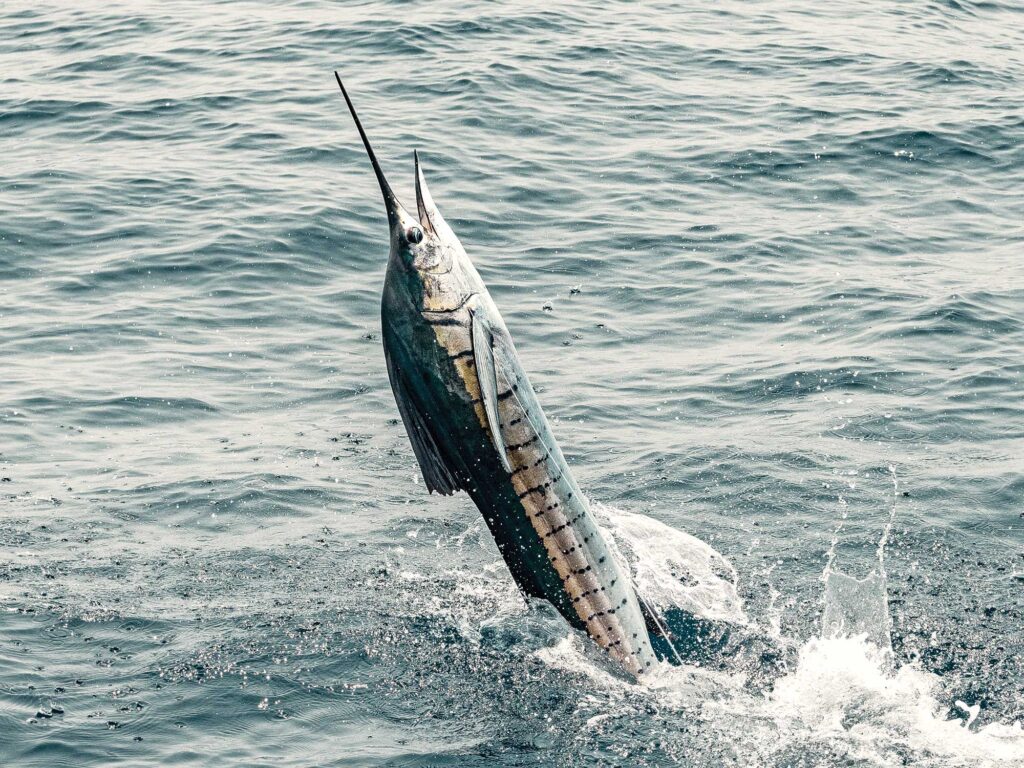
I fought the fish like a rusty offshore angler could be expected, bringing the sailfish to the stern in relatively short order. “Picture?” asked Emerson, his broken English way better than my Spanish. “Si,” I said, not knowing how many sailfish we’d catch.
That first fish was just what Andy, Dave and I needed. If we wanted to catch our own fish, we had to be quick. We had to watch the teasers and baits. We had to listen when our captain called out a fish. “Right long teaser!” Our mates were alert—they weren’t letting a billfish leave without feeling a hook. (In fact, the different local boats tend to compete with each other for the most raised fish, hooked fish and released fish for friendly bragging rights.)
But our mates were also good teachers, directing us when to drop a ballyhoo back or reel up to a teaser. Once a fish sucked down a ’hoo, it was a five-second wait before moving the lever to strike. Many times our circle hooks set strongly; sometimes they didn’t. In a place like Florida, every single sailfish matters. In Guatemala, it’s different. During our trip, anglers were catching so many fish, they lost count. Losing a sailfish wasn’t world-ending because another would soon follow. That sounds completely preposterous—and it is—but that’s sailfishing in Guatemala.
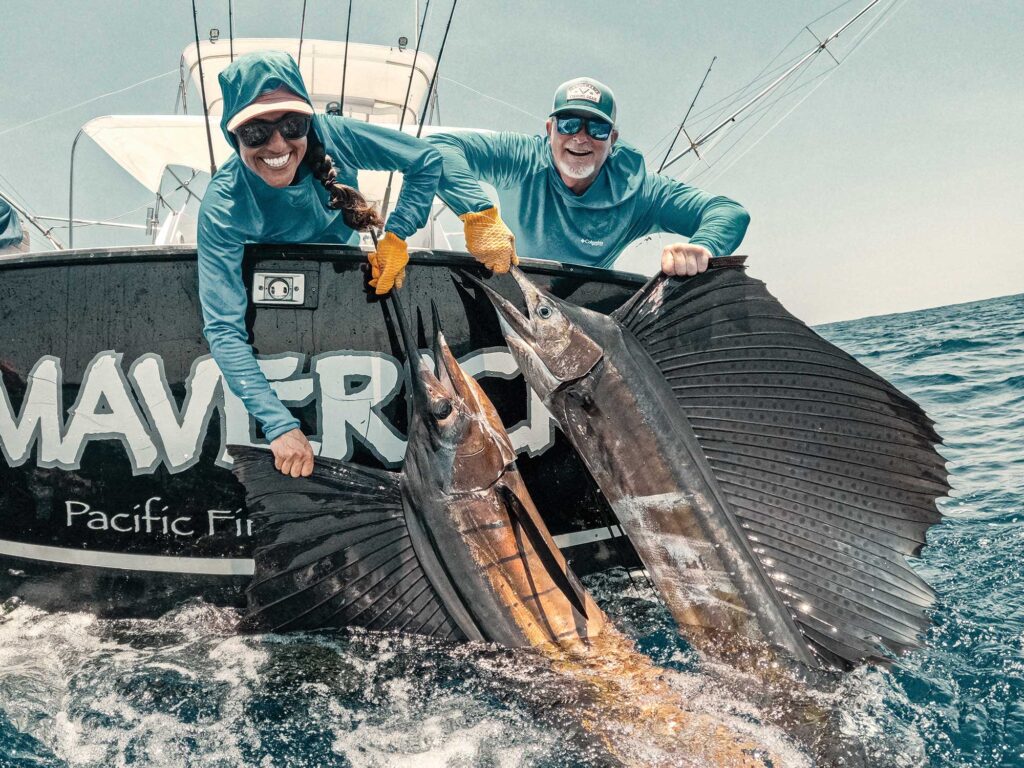
Make Mine a Quad
On our boat, we got into a rotation, mostly taking turns at catching and sometimes flubbing fish. Mixed in with sailfish were dorado (aka mahi) attacking our ballyhoo from left to right, not even giving us an opportunity to drop-back. Our mate filleted one of them and served it as sashimi with avocado, onion and soy sauce. Mates, like Emerson, fillet your dorado right on the boat and get them iced down quickly. For a short period, there’s a bunch of blood on the deck. And that allowed us to test Columbia’s Castback TC PFG shoes. Yes, they were comfy with the Techlite midsole, but they also had Omni-Shield Blood ’N Guts stain guard. That tech worked its magic, and every bit of dorado blood washed off our shoes with help from some ocean water.
At one point, Dave accidentally sat on a leftover plate and spilled soy sauce on his backside. His new Columbia PFG Uncharted pants were put to the test. But he wasn’t worried. A simple rinse from the washdown hose made short work of the sauce, and his pants dried quickly in the Guatemala sun—close call, great save.
The highlight of the day was a quad hookup. Doubling up on sailfish isn’t unusual. Even a triple hookup happens. But I’ve never experienced a quad. The whole situation started fairly routine. Our captain called out a sailfish, and we hooked up and settled in for the fight. The captain said to keep lines in, and then he made that unmistakable boat turn to cover the same water we just passed. That’s when rods two and three went off. With three anglers hooked up, we were ready for beers and fist bumps. But with Ricardo maneuvering a fourth rod around us, we all watched eagerly to see if he was going to hook a fourth fish. And he did—without much fanfare, just a smile.
Three fish cooperated, but one made a full circle around the boat, requiring a squirrelly run up to the bow. Dave’s and my sailfish came to the stern first, which were released quickly. Then Ricardo passed me his fish, and Andy and I fought and released the final two sails. All four sails were successfully caught and released, showing just how quickly sailfish numbers stack up in Guatemala.
Each of our boats averaged at least 20 sailfish releases the first day of fishing, with two or three anglers on each boat. Some anglers even took time to fly-fish for them with rods that needed plenty of backbone. One boat, Gypsy, released 46 sailfish, although the mates hooked the fish and passed the rods to their anglers.
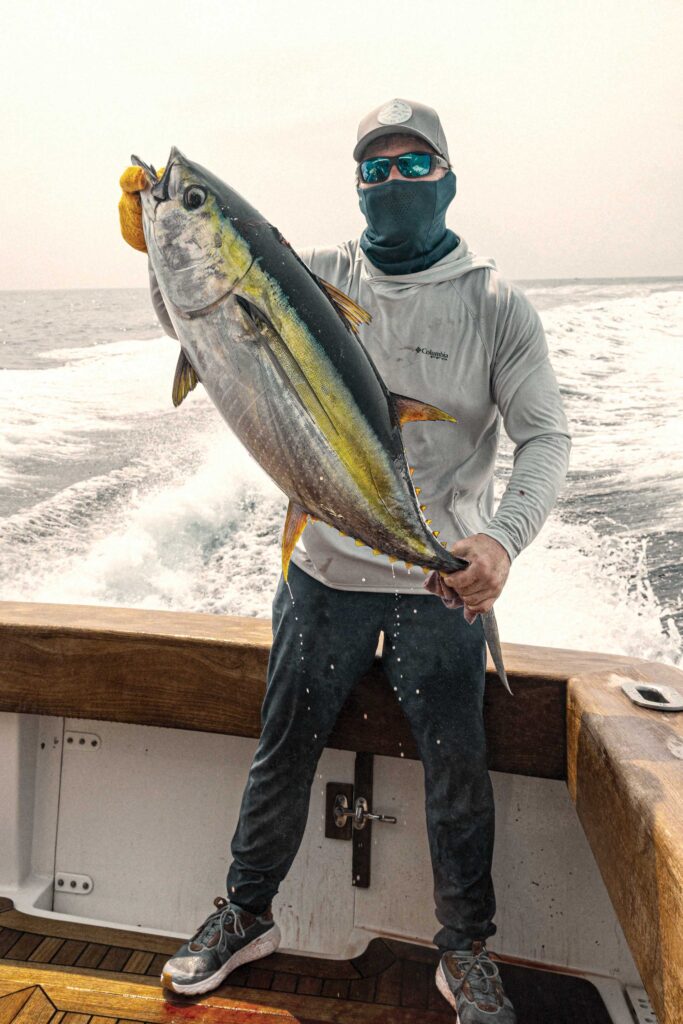
A Marlin Win, Tuna Loss
All the anglers aboard the trip agreed that the most satisfying fish caught were those where you did all the work yourself, from watching a sailfish windshield-wiping at your bait, to popping the line from the outrigger, to dropping back your ballyhoo near the teaser. Then to feel a fish take the bait and come tight—fighting the sailfish was just gravy.
But there are many other targets in Guatemala besides sailfish. Run-ins with striped marlin, yellowfin tuna and blue marlin are fairly routine. In fact, I experienced the mechanical precision of the mates’ actions when a blue marlin popped into the spread, tempted by a teaser.
On day two, the mates aboard Knotwork got to work. Capt. Nestor yelled “Marlin! Short teaser!” One mate, Andy, pulled the pre-rigged mackerel from the cooler ready on a 50-pound outfit while our other mate, Fernando, worked the teaser. In seconds, the blue came off the teaser and ate the mackerel tossed its way, with Andy providing the finishing touches via a side-motion hook-set.
Chris Megan, publisher of On the Water, received the rod from Andy and went hard after the blue marlin. Twenty minutes into the fight, he had the blue close enough for a leader touch, but that wasn’t the end of it. An aggressive tail-walking display by the marlin, from port to starboard, ended with the blue going deep for another half-hour. Eventually, Chris cranked the estimated 300-pounder to the boat for a -successful release.
Besides billfish, some anglers had their sights set on tuna. The greater area we were fishing was a spot called the Pocket. Currents bounce off the canyon walls here, concentrating the bait in the top of the water column, where billfish and tuna find them easily.
“The spinner dolphin highway is about 40 miles offshore,” explained Capt. Nestor. That’s where anglers can usually find yellowfins of all sizes. We were a bit too early in April—May is a great month—but other boats still caught tuna.
Some spinner dolphins were schooled up together tightly, not far from the sailfish grounds, so it wasn’t a major time suck to give it a shot. The anglers aboard Libertad, a 40-foot G&S, battled an estimated 150-plus-pound yellowfin for more than an hour. The community fish, with anglers taking turns on the rod, was as stubborn as a mule—so stubborn, the fish somehow broke free as the crew worked the leader and gaff during the endgame. The consolation prize for their lost fish was a mess of modest yellowfins that tasted spectacular as sushi.
But that’s Guatemala in a nutshell—so much potential that you can lose count of the number of fish caught and lost in a single day. And it’s still a better day than the majority of billfish destinations that each claim to be “the sailfish capital of the world.”
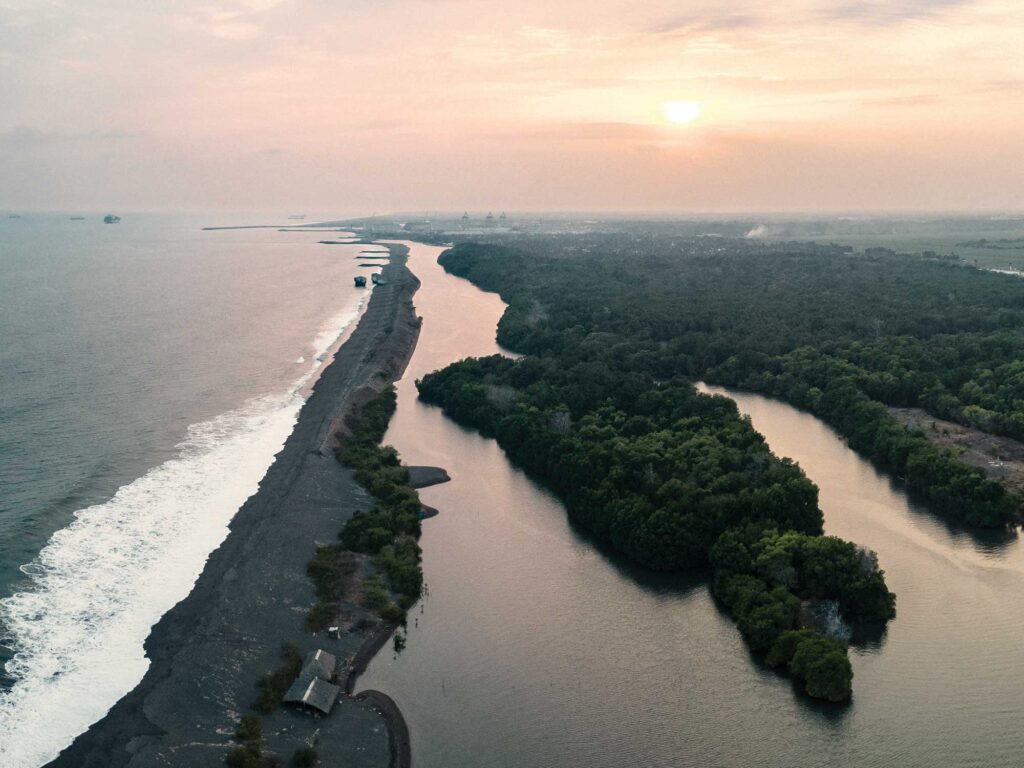
Getting There
When booking a fishing trip to Guatemala, a number of first-rate lodges are available, including the Pacific Fins Resort (in Iztapa) and Casa Vieja Lodge (in Puerto San Jose). Both lodges leave from the same port, and even from the same docks.
Fly into Guatemala City, where your fishing lodge will provide transportation to the coast, likely in a multirow Mercedes Sprinter van. The drive to the coast can take anywhere from two and a half to five hours. Along the way, be on the lookout for chicken buses—wildly colored and outfitted transportation vehicles that started as plain-old yellow school buses in the US. Once at the resort, you’ll have everything you need.
If you get a free day from fishing, check out Guatemala’s beaches that are black-colored from volcanic rock. Or take a day trip to Antigua, a thriving city surrounded by volcanoes and home to fantastic Baroque architecture, cobble streets, art galleries, authentic cuisine and traditional Guatemalan culture.
Read Next: Guide to Spring Sailfish Fishing
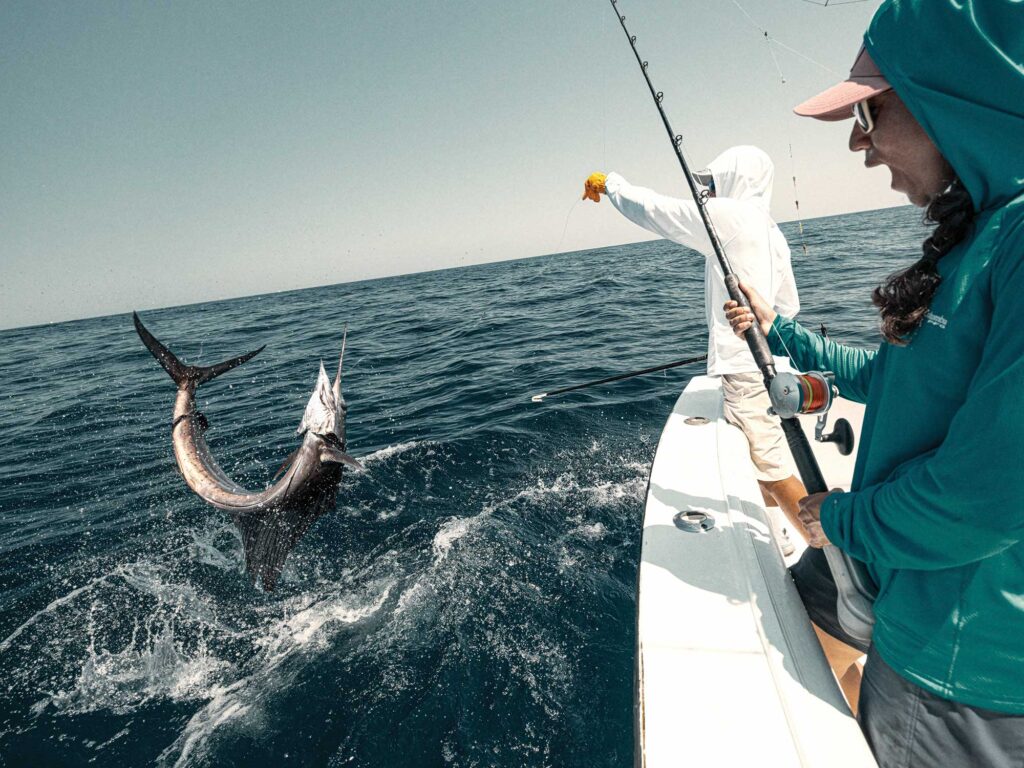
The Pacific Variety
If you check the IGFA’s world records, you’ll notice the record-keepers make a distinction between Pacific and Atlantic sailfish. The weights of the Pacific versions probably caught your eye too; they are undeniably heavier. If Atlantic sailfish are the lightweights, Pacific sailfish are the heavyweights. There’s not much to dispute.
The largest Atlantic sailfish swim in the waters off Angola, Nigeria and Senegal, with the current all-tackle record weighing 142 pounds, 6 ounces. Only one record sailfish hails from the US—a 105-pounder landed on 8-pound-test in Key West, Florida. In comparison, the top three largest recorded Pacific sailfish all exceed 200 pounds. White marlin don’t even grow to that size.
Along Guatemala’s western coast, anglers can expect to encounter plenty of Pacific pez vela, which are larger and beefier on average. However, don’t expect to weigh your catch at the docks, as countries like Costa Rica, Panama and Guatemala are strict about catch-and-release fishing. Be ready for a longer fight with traditional light tackle, along with some down-and-dirty and high-flying antics near the boat.



